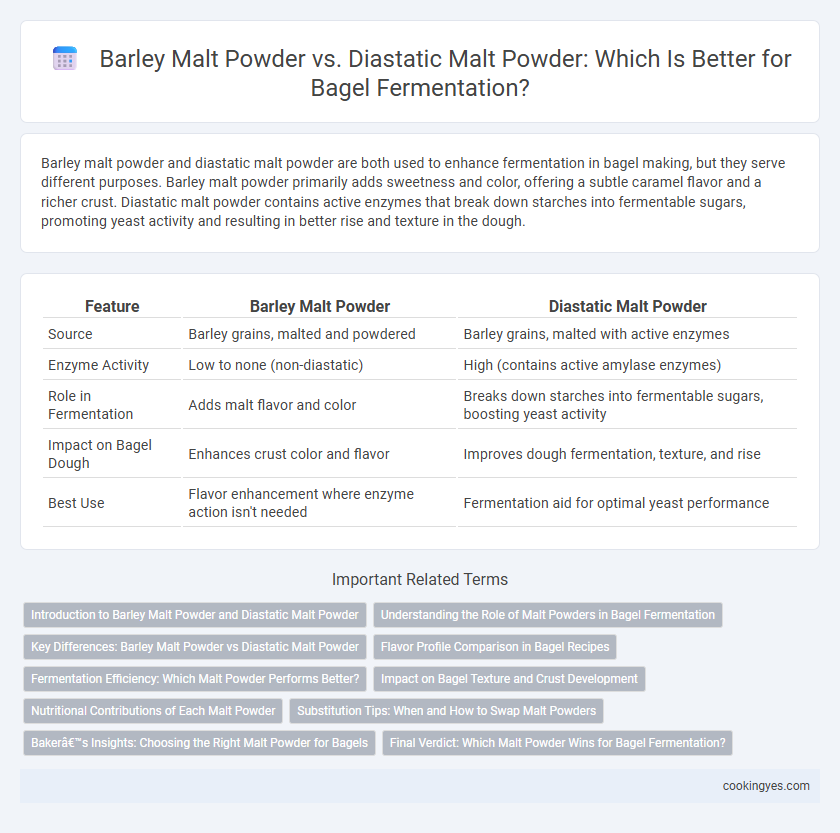Barley malt powder and diastatic malt powder are both used to enhance fermentation in bagel making, but they serve different purposes. Barley malt powder primarily adds sweetness and color, offering a subtle caramel flavor and a richer crust. Diastatic malt powder contains active enzymes that break down starches into fermentable sugars, promoting yeast activity and resulting in better rise and texture in the dough.
Table of Comparison
| Feature | Barley Malt Powder | Diastatic Malt Powder |
|---|---|---|
| Source | Barley grains, malted and powdered | Barley grains, malted with active enzymes |
| Enzyme Activity | Low to none (non-diastatic) | High (contains active amylase enzymes) |
| Role in Fermentation | Adds malt flavor and color | Breaks down starches into fermentable sugars, boosting yeast activity |
| Impact on Bagel Dough | Enhances crust color and flavor | Improves dough fermentation, texture, and rise |
| Best Use | Flavor enhancement where enzyme action isn't needed | Fermentation aid for optimal yeast performance |
Introduction to Barley Malt Powder and Diastatic Malt Powder
Barley malt powder and diastatic malt powder are essential in bagel fermentation, enhancing dough flavor and texture. Barley malt powder is made from roasted barley, providing sugars and a rich malt taste without enzymatic activity, while diastatic malt powder contains active enzymes that break down starches into fermentable sugars, promoting yeast activity and fermentation. Understanding their distinct roles allows bakers to optimize dough fermentation and achieve the characteristic chew and crust of authentic bagels.
Understanding the Role of Malt Powders in Bagel Fermentation
Barley malt powder enhances bagel fermentation by providing natural sugars that yeast consumes, improving dough rise and crust color through enzymatic activity. Diastatic malt powder contains active enzymes like amylase, which break down starches into fermentable sugars, accelerating fermentation and creating a chewier texture. Choosing between barley malt and diastatic malt powders affects the bagel's flavor profile, fermentation rate, and oven spring during baking.
Key Differences: Barley Malt Powder vs Diastatic Malt Powder
Barley malt powder is a non-diastatic product primarily used to enhance flavor, color, and sweetness in bagel dough, while diastatic malt powder contains active enzymes that break down starches into fermentable sugars, boosting fermentation and dough rise. The enzymatic activity in diastatic malt powder accelerates yeast performance and improves crumb texture, making it essential for dough structure and volume. Barley malt powder contributes mainly to taste and crust browning without influencing fermentation significantly.
Flavor Profile Comparison in Bagel Recipes
Barley malt powder enhances bagel dough with a subtle sweetness and rich, caramelized flavor, contributing to a well-rounded taste and a glossy crust. Diastatic malt powder contains active enzymes that boost fermentation by breaking down starches into fermentable sugars, resulting in a lighter texture and slightly tangy flavor. Choosing barley malt powder emphasizes flavor depth and color, while diastatic malt powder optimizes fermentation and crumb structure in bagel recipes.
Fermentation Efficiency: Which Malt Powder Performs Better?
Diastatic malt powder contains active enzymes that break down starches into fermentable sugars, significantly enhancing fermentation efficiency in bagel dough. Barley malt powder, while rich in flavor, has limited enzymatic activity, providing minimal impact on sugar availability for yeast fermentation. For optimal fermentation performance and improved dough rise, diastatic malt powder outperforms barley malt powder in bagel baking.
Impact on Bagel Texture and Crust Development
Barley malt powder enhances bagel crust development by promoting browning and a slightly sweeter flavor, contributing to a chewy texture. Diastatic malt powder contains active enzymes that break down starches into fermentable sugars, accelerating fermentation and producing a lighter, more aerated crumb. Using diastatic malt powder results in a softer interior texture, while barley malt powder primarily strengthens crust color and flavor without significantly altering crumb structure.
Nutritional Contributions of Each Malt Powder
Barley malt powder is rich in sugars and enzymes that enhance fermentation by providing readily fermentable carbohydrates, boosting yeast activity and improving crust color and flavor complexity. Diastatic malt powder contains active enzymes, primarily amylase, which break down starches into fermentable sugars, aiding yeast reproduction and contributing to a lighter, well-risen crumb. Both malt powders add essential nutrients, but diastatic malt offers a higher enzymatic activity beneficial for dough development and fermentation efficiency.
Substitution Tips: When and How to Swap Malt Powders
Barley malt powder and diastatic malt powder both enhance bagel fermentation but serve distinct roles: barley malt powder adds flavor and color without enzymatic activity, while diastatic malt powder contains active enzymes that break down starches into fermentable sugars. Substitute barley malt powder for diastatic malt powder when only mild fermentation improvement and sweetness are desired, but avoid swapping diastatic malt powder for barley malt in recipes sensitive to enzymatic activity to prevent over-fermentation. Use about half the amount of diastatic malt powder when substituting for barley malt to balance enzymatic effects and maintain dough consistency.
Baker’s Insights: Choosing the Right Malt Powder for Bagels
Barley malt powder contains non-enzymatic malt extract, providing a rich flavor and deep color to bagels, while diastatic malt powder contains active enzymes that enhance fermentation by breaking down starches into sugars, boosting yeast activity and oven spring. Bakers select barley malt for a traditional chewy crust and caramelized crust, whereas diastatic malt is preferred when a stronger fermentation and rise are desired. The choice depends on the desired texture and fermentation intensity, with diastatic malt powder optimizing yeast performance for fluffier bagels and barley malt enriching the flavor profile.
Final Verdict: Which Malt Powder Wins for Bagel Fermentation?
Barley malt powder enhances bagel fermentation by providing a rich source of fermentable sugars and flavor complexity, resulting in a chewy crust and deep golden color. Diastatic malt powder contains active enzymes that break down starches into sugars, accelerating fermentation and improving dough rise and texture. For optimal bagel fermentation, diastatic malt powder is preferred due to its enzymatic activity, which promotes a more efficient rise and characteristic bagel chewiness.
Barley malt powder vs Diastatic malt powder for fermentation Infographic

 cookingyes.com
cookingyes.com